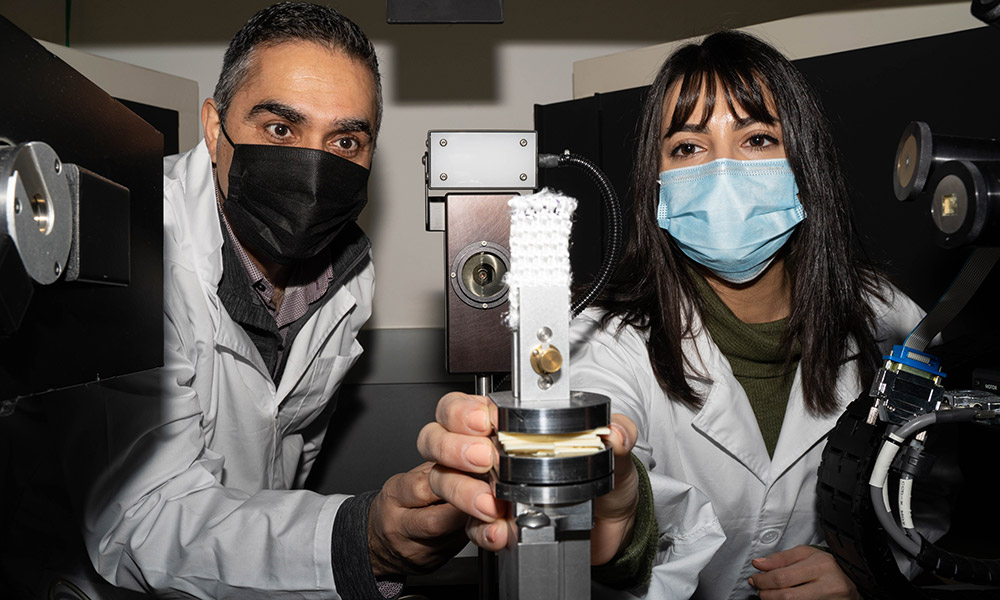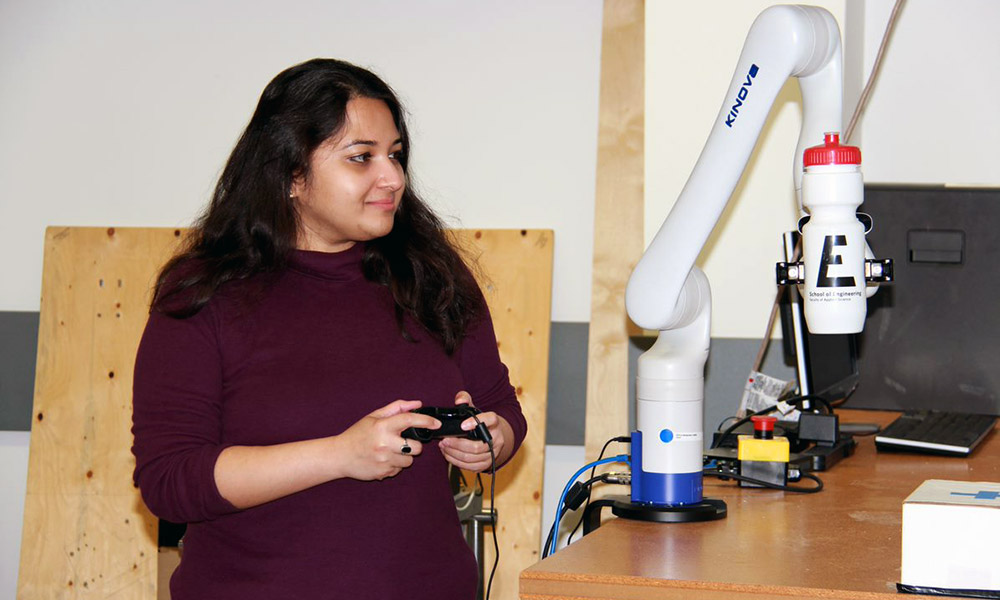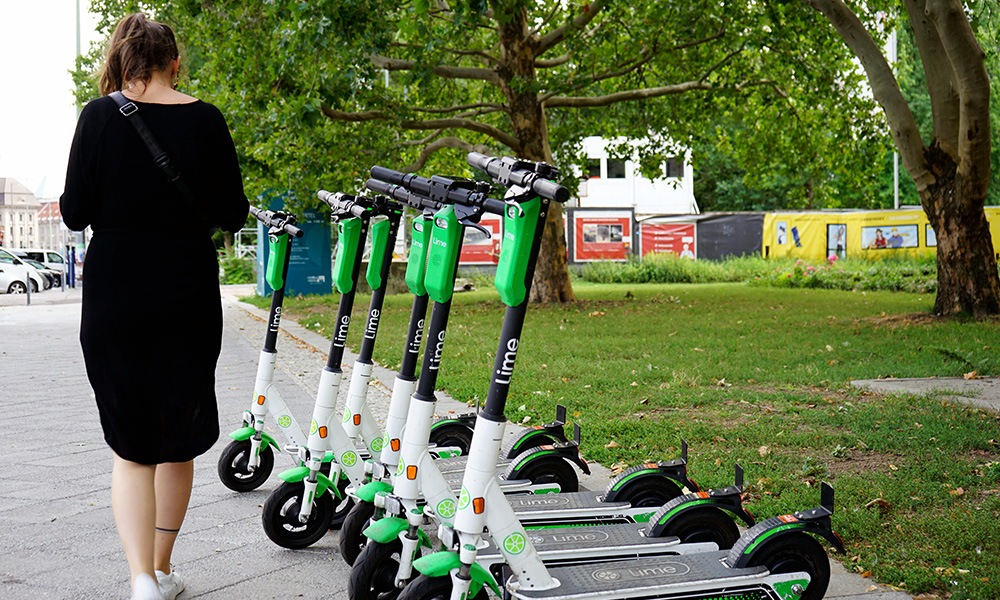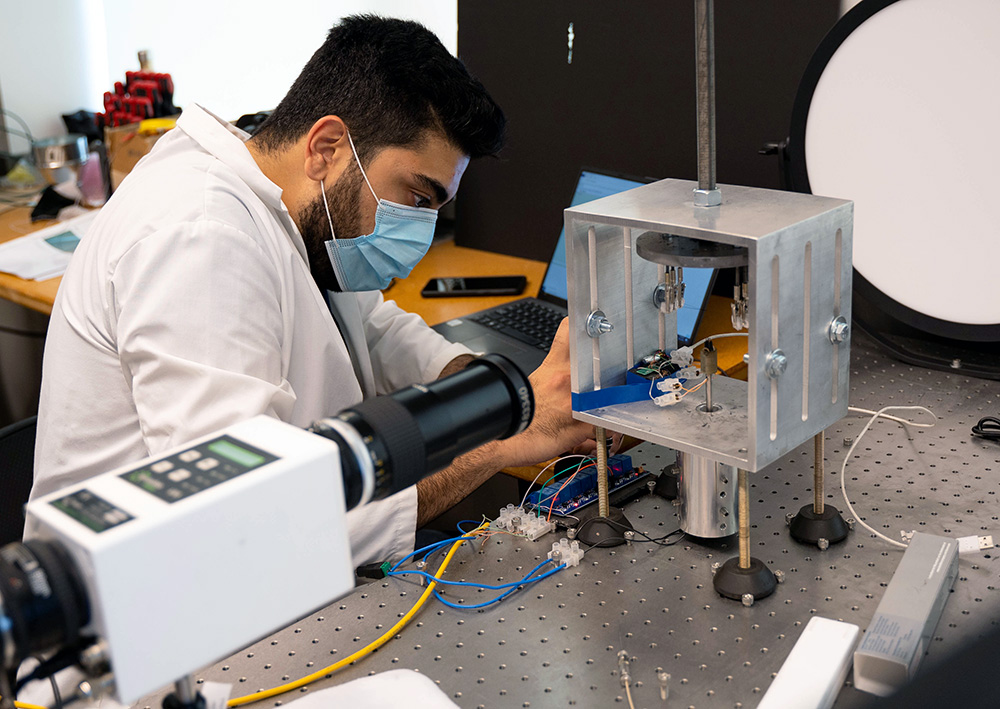
UBCO professor Abbas Milani and doctoral student Tina Olfatbakhsh use X-ray computed tomography to capture high-resolution 3D images of composite materials to study their internal structure.

UBCO professor Abbas Milani and doctoral student Tina Olfatbakhsh use X-ray computed tomography to capture high-resolution 3D images of composite materials to study their internal structure.
Posted in Uncategorized

A bank of lithium-tellurium batteries is tested at UBCO’s Advanced Materials for Energy Storage Lab.

UBCO doctoral student Yue Zhang holds up a sample of tellurium, while Dr. Jian Liu shows a tiny and powerful disc battery that uses the mining waste product.
Posted in Uncategorized | Tagged Batteries, EV, Fenix Advanced Materials, Jian, Liu, tellurium
 What: Fourth annual Life Raft Debate
Who: UBC professors debate to win a seat in a time machine and change history
When: Wednesday, January 26, beginning at 7 pm
Venue: Online, virtual event
Once again, UBC Okanagan professors are being called upon to share their expertise and help save the world. But this year, it involves going back in time to right the wrongs of humanity.
The annual Life Raft Debate is a fun way to showcase the talents of professors by using an “end-of-the-world” premise, explains Lyndsey Chesham, Society of Scholars Program Assistant and a fourth-year microbiology student. The professors must do their best to sway the audience to earn the last seat on the life raft. However, this year it’s a seat in a time machine.
“For this year’s debate, humans have made an irrevocable mistake leading to our demise,” Chesham says. “Our only option is an experimental time machine capable of sending someone on a one-way trip to the first known human civilization.”
The catch? There is only one seat in the time machine. Not only must the time traveller win the debate, they must—without any modern technology—be able to influence society to not make the same mistakes. It’s up to them to prevent the downfall of the human race.
“Our traveller must assert the importance of their discipline in order to lead the ancient society, fix the mistakes of the past, and lead us to a brighter, more promising future,” adds Chesham. “But we must also question if it is even worth sending anyone back at all. It’s up to our audience to decide who we send, or if we even bother.”
Competing for the chance to time travel include chemistry’s Dr. Tamara Freeman, creative writing’s Michael V. Smith, engineering’s Dr. Vicki Komisar, psychology’s Dr. Liane Gabora and management’s Tamara Ebl. Associate Dean of Research Dr. Dean Greg Garrard will play the role of devil’s advocate, suggesting no one deserves to go back in time.
After all the words are spoken, the audience—using Zoom technology—will decide if someone does go back and restart society. And who it will be.
“The Society of Scholars brought this student-led event to UBCO to give students a chance to get to know their professors through the scope of a light-hearted and fun event,” adds Chesham. “Our debaters get very passionate and it is wonderful to see the professors speak about their life’s work so enthusiastically.”
New this year will be opening remarks from UBC President Santa Ono and closing remarks from UBCO’s Deputy Vice-Chancellor and Principal Lesley Cormack.
The Life Raft Debate takes place Wednesday, January 26 at 7 pm. It is a free, virtual presentation and follows with a question and answer session. To register or find out more, visit: students.ok.ubc.ca/life-raft
What: Fourth annual Life Raft Debate
Who: UBC professors debate to win a seat in a time machine and change history
When: Wednesday, January 26, beginning at 7 pm
Venue: Online, virtual event
Once again, UBC Okanagan professors are being called upon to share their expertise and help save the world. But this year, it involves going back in time to right the wrongs of humanity.
The annual Life Raft Debate is a fun way to showcase the talents of professors by using an “end-of-the-world” premise, explains Lyndsey Chesham, Society of Scholars Program Assistant and a fourth-year microbiology student. The professors must do their best to sway the audience to earn the last seat on the life raft. However, this year it’s a seat in a time machine.
“For this year’s debate, humans have made an irrevocable mistake leading to our demise,” Chesham says. “Our only option is an experimental time machine capable of sending someone on a one-way trip to the first known human civilization.”
The catch? There is only one seat in the time machine. Not only must the time traveller win the debate, they must—without any modern technology—be able to influence society to not make the same mistakes. It’s up to them to prevent the downfall of the human race.
“Our traveller must assert the importance of their discipline in order to lead the ancient society, fix the mistakes of the past, and lead us to a brighter, more promising future,” adds Chesham. “But we must also question if it is even worth sending anyone back at all. It’s up to our audience to decide who we send, or if we even bother.”
Competing for the chance to time travel include chemistry’s Dr. Tamara Freeman, creative writing’s Michael V. Smith, engineering’s Dr. Vicki Komisar, psychology’s Dr. Liane Gabora and management’s Tamara Ebl. Associate Dean of Research Dr. Dean Greg Garrard will play the role of devil’s advocate, suggesting no one deserves to go back in time.
After all the words are spoken, the audience—using Zoom technology—will decide if someone does go back and restart society. And who it will be.
“The Society of Scholars brought this student-led event to UBCO to give students a chance to get to know their professors through the scope of a light-hearted and fun event,” adds Chesham. “Our debaters get very passionate and it is wonderful to see the professors speak about their life’s work so enthusiastically.”
New this year will be opening remarks from UBC President Santa Ono and closing remarks from UBCO’s Deputy Vice-Chancellor and Principal Lesley Cormack.
The Life Raft Debate takes place Wednesday, January 26 at 7 pm. It is a free, virtual presentation and follows with a question and answer session. To register or find out more, visit: students.ok.ubc.ca/life-raft Posted in Media Advisory | Tagged campus, engineering, event, Komisar

UBC Okanagan Assistant Professor Dr. Sepideh Pakpour, along with student researchers Enrique Calderon and Rita Lam, examine a sample beside the natural light experimentation chamber. Their research suggests light through smart windows can work as a natural disinfectant against many illnesses including E.Coli and methicillin-resistance Staphylococcus aureus.
Posted in Uncategorized | Tagged Calderon, germs, Lam, Pakpour, UV, View, windows

UBCO research has determined that during the pandemic, online grocery shopping habits have changed considerably, but only for certain demographics. Photo by Pickawood on Unsplash
Posted in Uncategorized | Tagged Fatmi, groceries, Online, shopping, Transportation

UBCO doctoral student Debasmita Mukherjee, with the School of Engineering’s Advanced Control and Intelligent Systems Laboratory, is looking at ways to program robots so they can work safely alongside people.
Posted in Uncategorized | Tagged control systems, Mukherjee, Najjaran, Robotics

A UBC Okanagan study created a demand model for e-scooter use in the City of Kelowna, determining the most popular times and areas for their use. Photo by Vince Jacob on Unsplash.
Posted in Uncategorized

A droplet of fuel mixed with nanomaterials is ignited during an experiment in UBCO’s Combustion for Propulsion and Power Lab.

UBCO researcher Sepehr Mosadegh tests the ignition delay and burn rate of fuel mixed with graphene oxide with the hopes of creating a greener, but more powerful, aircraft fuel.
Posted in Uncategorized | Tagged Aviation, Fuel, Sepehr Mosadegh, Sina Kheirkhah

UBCO School of Engineering researchers Mohammad Arjmand, Jian Liu and Amir Ahmadian examine a conductive polymer nanocomposite sample, created from non-recyclable plastic and rubber waste, that can be used for electrical applications.
Posted in Uncategorized

UBC Okanagan researcher Saeed Mohammadiun’s work involves reviewing marine oil spill management including how computational techniques based on real-time data can be applied to an effective oil spill response.
Posted in Uncategorized